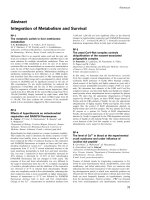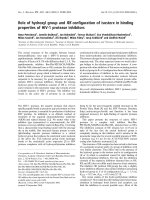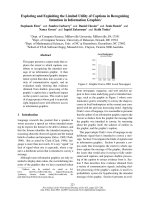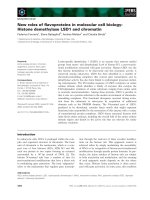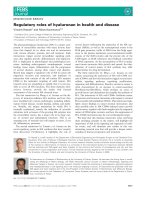Zebrafish liver and pancreas development 1 roles of rbp4 in early liver formation 2 genetic ablation to deduce pancreas cell lineage
Bạn đang xem bản rút gọn của tài liệu. Xem và tải ngay bản đầy đủ của tài liệu tại đây (14.34 MB, 205 trang )
ZEBRAFISH LIVER AND PANCREAS DEVELOPMENT:
1. ROLES OF RBP4 IN EARLY LIVER FORMATION;
2. GENETIC ABLATION TO DEDUCE
PANCREAS CELL LINEAGE
LI ZHEN
NATIONAL UNIVERSITY OF SINGAPORE
2007
ZEBRAFISH LIVER AND PANCREAS DEVELOPMENT:
1. ROLES OF RBP4 IN EARLY LIVER FORMATION;
2. GENETIC ABLATION TO DEDUCE
PANCREAS CELL LINEAGE
LI ZHEN
(B.Sc, Ocean University of China, China;
M.Sc, Ocean University of China, China)
A THESIS SUBMITTED
FOR THE DEGREE OF DOCTOR OF PHILOSOPHY
DEPARTMENT OF BIOLOGICAL SCIENCES
NATIONAL UNIVERSITY OF SINGAPORE
2007
Acknowledgements
I
Acknowledgements
I want to extend my greatest gratitude to my honorific supervisors: Prof. Gong
Zhiyuan (Department of Biological Sciences, NUS) and A/P Vladimir Korzh
(Institute of Molecular and Cell Biology), for taking me as their student and
appreciated their invaluable guidance and encouragement offered throughout my
apprenticeship. I also wish to give my heartfelt thanks to my PhD committee members,
A/P Hong Yunhan (Department of Biological Sciences, NUS) and Assistant Prof.
Jiang Yunjin (Institute of Molecular and Cell Biology), for their helpful ideas and
insights.
My research work has been done in both labs in Department of Biological
Sciences, NUS and Institute of Molecular and Cell Biology. I really appreciate the
favors from all the friendly people: Cecilia, Hendrian, Hu Jing, Huiqing, Qingwei,
Shizhen, Siew Hong, Tong Yan, Tuan Leng, Vivien, Weiling, Xiaoming, Xiao Ke,
Xingjun, Xiufang, Yan Tie, Yilian, Zhengyuan, Zhiqiang from Dr Gong’s lab; and
Ben, Catheleen, Dimitri, Gao Rong, Hang, Igor, Kar Lai, Lana, Lee Thean,
Marta, Michael, Mike, Rayner, Sasha, Sergei, Shangwei, William, Zhanrui from
Dr Korzh’s lab. Special thanks to Steven Fong, for his painstaking proofreading and
invaluable suggestions. Also, I would like to thank people from the general office of
DBS and the fish facility in the DBS and TLL/IMCB for their great assistants. In
addition, I would like to render my appreciation to National University of Singapore
for providing me the graduate research scholarship during these years.
Finally, I dedicate this thesis to my dearest parents and family members: mother
Tan Ruiqin, father, Li Xinyi, sister, Li Tao and husband Wang Tao whose love
and care empowered me to pursue my dream and interest in research.
Table of contents
II
Acknowledgements
I
Table of Contents
II-V
Summary
VI-VII
List of Tables
VIII
List of Figures
IX-X
List of Common Abbreviations
XI-XII
Publications
XIII
Chapter I. Introduction
1
1.1 Zebrafish embryonic development
3
1.2 Endoderm development
6
1.2.1 Gastrulation and early endoderm formation 6
1.2.2 Gut tube formation 7
1.3 Liver development
8
1.3.1 Liver progenitors 10
1.3.2 Signaling pathways in liver development 11
1.3.2.1 Liver competency and specification 11
1.3.2.2 Liver bud formation 12
1.3.2.3 Liver growth and differentiation 13
1.4 Pancreas development and cell lineage relationship
14
1.4.1 Exocrine pancreas 15
1.4.2 Endocrine pancreas 16
1.4.3 Signaling pathways and gene regulatory factors
in pancreas development
17
1.4.3.1 Early pancreas specification 17
1.4.3.2 Pancreas bud formation 18
1.4.3.3 Pancreatic specification 19
1.4.3.4 Exocrine pancreas specification 20
1.4.3.5 Endocrine pancreas specification 21
1.4.4 Lineage analysis methodologies 22
1.4.5 Exocrine and endocrine pancreas cell lineage relationship 23
1.5 Rationale and objectives of the proposed study
25
Chapter II. Materials and Methods
27
2.1 DNA applications
28
2.1.1 DNA preparation and purification 28
2.1.1.1 Isolation and purification of plasmid DNA 28
2.1.1.2 cDNA synthesis 29
2.1.1.3 Recovery of DNA fragments from agarose gel 29
2.1.2 Recombinant DNA 29
Table of contents
III
2.1.2.1 Restriction endonuclease digestion of DNA 29
2.1.2.2 DNA electrophoresis 30
2.1.2.3 Quantification of DNA by spectrophotometry 30
2.1.2.4 Ligation 30
2.1.2.5 Transformation 30
2.1.2.5.1 Preparation of competent cells 30
2.1.2.5.2 Transformation 31
2.1.2.6 Colony screening 31
2.1.3 Polymerase chain reaction (PCR) 32
2.1.3.1 Standard PCR 32
2.1.3.2 Reverse transcription PCR (RT-PCR) 34
2.1.3.3 Purification of PCR products 36
2.1.3.4 PCR product subcloning 36
2.1.4 DNA sequencing reaction 36
2.1.5 DNA vectors 38
2.1.5.1 pBluescript SK(+) 38
2.1.5.2 pGEM®-T Easy 39
2.1.5.3 pDrive 40
2.1.5.4 pEGFP-1 41
2.1.5.5 pDsRed-Express-1 42
2.1.5.6 DTA-mediated cell ablation 43
2.2 RNA applications
43
2.2.1 Isolation of total RNA 43
2.2.1.1 Isolation of total RNA from zebrafish embryos 43
2.2.1.2 Measurement of RNA concentration 44
2.2.1.3 RNA gel electrophoresis 44
2.3 Expression Analysis
45
2.3.1 Zebrafish 45
2.3.1.1 Fish maintenance 45
2.3.1.2 Mutant lines of zebrafish 45
2.3.2 Microinjection 45
2.3.2.1 Microinjection into 1-cell stage 45
2.3.2.2 Microinjection into YSL at 4 hpf stage 46
2.3.3 Anti-sense morpholino design 46
2.3.4 Whole mount in situ hybridization on zebrafish embryos 50
2.3.4.1 Synthesis of labeled RNA probe 50
2.3.4.1.1 Linearization of plasmid DNA 50
2.3.4.1.2 Probe incubation and precipitation 50
2.3.4.1.3 Quantification of labeled probe 51
2.3.4.2 Preparation of zebrafish embryos 51
2.3.4.2.1 Embryo collection and fixation 51
2.3.4.2.2 Use of Anesthetic to View Embryos 52
2.3.4.2.3 Proteinase K treatment 52
2.3.4.2.4 Prehybridization 52
2.3.4.3 Hybridization 53
2.3.4.4 Post-Hybridization washes 53
2.3.4.5 Antibody incubation 53
2.3.4.5.1 Preparation of preabsorbed DIG 53
2.3.4.5.2 Incubation with preabsorbed antibodies 54
2.3.4.6 Color development 54
Table of contents
IV
2.3.4.7 Two-color whole mount in situ hybridization 54
2.3.5 Immunohistochemical staining 56
2.3.5.1 Primary antibody incubation 56
2.3.5.2 Secondary antibody incubation 56
2.3.5.3 Detection 56
2.3.6 Cryostat section 56
2.3.7 Double staining with mRNA probe and
immunohistochemical staining
57
2.3.8 DAPI staining 57
2.3.9 Mounting and photography 58
2.3.10 Confocal microscopy and imaging of living embryos
after anesthetizing
58
Chapter III. Role of zebrafish retinol binding protein 4 (rbp4)
gene on early liver development
60
3.1 Spatial and temporal expression of rbp4 gene during embryogenesis
62
3.1.1 Sequence analyses of rbp4 cDNA 62
3.1.2 Temporal expression of rbp4 gene from fertilization onwards 63
3.1.3 Spatial expression of rbp4 gene 63
3.2 Regulation of rbp4 gene expression
67
3.2.1 rbp4 gene expression pattern in YSL changed
in mutants belonging to nodal and hh signaling pathway
67
3.2.2 RA positively regulates rbp4 expression in YSL 68
3.3 Knockdown of rbp4 gene results in change of yolk shape
and double liver formation
70
3.3.1Yolk and yolk extension shape changed in rbp4 gene knockdown 70
3.3.2 Two liver buds formed at both left and right side
in rbp4 gene knockdown
76
3.3.3 Exocrine pancreas, endocrine pancreas and heart
remain normal after rbp4 knockdown
83
3.4 Discussion
85
Chapter IV. Isolation of somatostatin2 (sst2) and glucagona
(gcga) promoters and generation of gfp transgenic zebrafish
93
4.1 Isolation of zebrafish sst2 gene promoter and establishment of stable
GFP transgenic line under the sst2 promoter
96
4.1.1 Sequence analysis of zerafish sst2 promoter 96
4.1.2 Specific activation of gfp reporter gene in endocrine pancreas
and floor plate cells under the 2,467-bp zebrafish sst2 promoter
103
4.1.3 Generation and characterization of stable Tg(sst2:gfp) lines 108
4.1.4 GFP expression in adult Tg(sst2:gfp) 113
4.2 Isolation and characterization of zebrafish and fugu gcg promoters
116
4.2.1 zebrafish gcga promoter 116
4.2.2 Fugu gcga promoter 119
4.3 Discussion
121
4.3.1 sst2 promoter analysis 121
4.3.2 Generation of stable Tg(sst2:gfp) line and analysis of pancreas
development
122
4.3.3 gcga promoter analysis 125
Table of contents
V
Chapter V. Analysis of zebrafish exocrine
and endocrine pancreas lineage
128
5.1 Ablation of the exocrine pancreas
130
5.1.1 Specific ablation of exocrine pancreas
by transient expression of DTA under the elaA promoter
130
5.1.2 Endocrine cells are not affected by pElaA-DTA ablation 134
5.2 Ablation of ins expressing β-cells
138
5.2.1 Specific ablation of ins expressing β-cells
by transient expression of DTA under the ins promoter
138
5.2.2 Analysis of recovery of β-cells in pINS-DTA affected embryos 142
5.2.3 Effect of β-cell ablation on α- and δ-cells 146
5.3 Ablation of sst2 expressing δ-cells
150
5.3.1 Specific ablation of δ-cells
by transient expression of DTA under the sst2 promoter
150
5.3.2 Analysis of recovery of δ-cells in δ-cell ablation 154
5.3.3 Effect of δ-cell ablation on β- and α-cell 157
5.3.3.1 Effect of δ-cell ablation on β-cells 157
5.3.3.2 Effect of δ-cell ablation on α-cells 160
5.4 Effects of endocrine pancreatic cell ablation on
development of exocrine pancreas, liver and intestine
165
5.5 A tentative model of zebrafish
endocrine pancreas cell lineage relationship
167
References
170
Summary
VI
SUMMARY
Liver and pancreas are endoderm organs possessing both endocrine and exocrine
functions. Although their development has been intensively studies in mammals, the
knowledge on liver progenitors and pancreas cell lineage remains poor. As such, the
zebrafish, a promising model for development study, has been used in this study to
investigate the two aspects.
To investigate the early liver development, expression and function of a gene
encoding retinol binding protein 4 (Rbp4), a plasma transporter of retinol, was
analyzed. rbp4 was expressed in the ventro-lateral yolk syncytial layer (YSL) at 12-16
hpf and later expanded to cover the posterior YSL. We demonstrated that rbp4
expression was negatively regulated by Nodal and Hedgehog (Hh) signalling and
positively controlled by retinoic acid. Knockdown of Rbp4 in the YSL resulted in
shortened yolk extension as well as the formation of two liver buds, which could be
due to impaired migration of liver progenitor cells. Rbp4 appeared also to regulate the
gene encoding the extracellular matrix protein Fibronectin1 (Fn1) specifically in the
ventro-lateral yolk, indicating a role of fn1 in liver progenitor migration. Since
exocrine pancreas, endocrine pancreas, intestine and heart developed normally in
Rbp4 morphants, we suggest that rbp4 expression in the YSL is required only for
early liver development, especially for migration of liver progenitors.
To study the pancreas cell lineage relationship, we firstly isolated and
characterized the zebrafish somatostatin 2 (sst2) and glucagon a (gcga) promoters.
Using the zebrafish sst2 promoter, we successfully generated three GFP transgenic
lines that faithfully recapitulated sst2 expression in the endocrine pancreas. Secondly,
we employed diphtheria toxin gene A chain (DTA) mediated cell ablation method to
eliminate either exocrine pancreas (elaA expressing cells) or endocrine pancreas (ins
Summary
VII
or sst2 expressing cells). It turned out that endocrine pancreas and exocrine pancreas
are independent of each other during development. Among endocrine pancreas, we
showed that ablation of the β-cells resulted in more profound defects in α-cells and
almost no defects in δ-cells, while ablation of δ-cells resulted in reduction both in α-
and β-cells. In addition, we showed that ablations of either exocrine pancreas cells or
endocrine pancreas (β- and δ-) cells have no obvious effect on development of other
endodermal organs such as the liver and intestine.
In conclusion, this study explored two aspects of endoderm development in
zebrafish. By investigation of rbp4 gene, we showed that YSL expressing rbp4 has
specific function in early liver development especially in migration of liver
progenitors, indicating a role of retinol in early liver development. By study of
pancreas cell lineage in zebrafish, we suggested that while morphogenesis of pancreas
is largely evolutionary conserved, minor difference in the cell lineage relationship of
endocrine cells may exist between fish and mammals.
List of tables
VIII
List of Tables
Table 2-1 Primers Used in Standard PCR 33
Table 2-2 Primers Used in RT-PCR 35
Table 2-3 A List of Morpholinos (MO) Used in This Study. 49
Table 3-1 Morphological phenotype of rbp4 morphants 74
Table 3-2 Evaluation of rbp4 morphants by transferrin expression 78
Table 5-1 Summary of phenotypes of Tg(elaA:gfp) embryos after
injection of pElaA-DTA at 6 dpf
132
Table 5-2 Summary of phenotypes of Tg(ins:gfp) embryos at 26 hpf
after injection of pINS-DTA
141
Table 5-3 Summary of phenotypes after injection of pINS-DTA 144
Table 5-4 Summary of phenotypes of Tg(sst2:gfp) embryos after
injection of pSST2-DTA at 26hpf
152
Table 5-5 Summary of phenotypes after injection of pSST2-DTA 155
List of figures
IX
List of Figures
Fig. 2-1 pBluescript SK (+/-) vector map 38
Fig. 2-2 pGEM-T Easy vector map 39
Fig. 2-3 pDrive vector map 40
Fig. 2-4 pEGFP-1 vector map 41
Fig. 2-5 pDsRed-Express-1 vector map 42
Fig. 3-1 Sequence alignment of zebrafish, carp, rainbow trout, xenopus,
chick, rabbit, mouse and human Rbp4s
65
Fig.3-2 Expression of rbp4 mRNA during early zebrafish embryogenesis 66
Fig.3-3 Analyses of rbp4 expression during late development and its
regulation
69
Fig.3-4 RT-PCR results showed the specificity of rbp4 Spl-MO 72
Fig.3-5 Effects of Rbp4 splicing MO on morphology of embryos 75
Fig.3-6 Analyses of liver and midline structures development in Rbp4
morphants
79
Fig.3-7 Rbp4 MO affects the early events of liver patterning prior to
formation of liver bud
82
Fig.3-8 Analyses of pancreas and heart development in Rbp4 morphants. 84
Fig. 4-1 Sequence of zebrafish proximal sst2 promoter region 98
Fig. 4-2 Comparison of sst promoter among human, mouse, rat and
zebrafish
100
Fig. 4-3 Comparison of transcription factor binding sites between the
2,500-bp rat sst promoter and the 2,467-bp zebrafish sst2
promoter
102
Fig. 4-4 WISH of sst2 and transient expression of GFP under the 2,467-
bp sst2 promoter
104
Fig. 4-5 5’ deletion analysis of the 2,467-bp sst2 promoter. 107
Fig. 4-6 GFP expression of Tg(sst2:gfp) (line 1) during embryonic and
early larva development.
110
Fig. 4-7 GFP expression of Tg(sst2:gfp) in the intestinal cells during
embryonic and early larva development.
112
Fig. 4-8 GFP expression in adult Tg(sst2:gfp) and Tg(ins:gfp) 115
Fig. 4-9 Zebrafish proximal gcga promoter sequence 118
Fig. 4-10 Fugu gcg promoter sequence 120
Fig. 5-1 Effects of exocrine pancreas ablation by injection of pElaA-DTA 133
Fig. 5-2 Effects of exocrine pancreas ablation on endocrine pancreatic
cells
136
List of figures
X
Fig. 5-3 Ablation of β-cells by specific expression of DTA under the ins
promoter
139
Fig. 5-4 Effect of β-cell ablation on endocrine pancreas cells 145
Fig. 5-5 Summary of β-cell ablation 147
Fig. 5-6 Double in situ hybridization of ins (red) and gcga (blue) on wild
type and pINS-DTA injected embryos
149
Fig. 5-7 Ablation of δ-cells by specific expression of DTA under the
zebrafish sst2 promoter.
153
Fig. 5-8 Effect of δ-cell ablation on endocrine pancreas cells 156
Fig. 5-9 Summary of δ- and β-cell and after δ-cell ablation 159
Fig. 5-10 Summary of α -cell after δ-cell ablation 162
Fig. 5-11 Double in situ hybridization of ins (blue)/sst2 (red) 163
Fig. 5-12 Effect of endocrine pancreas ablation on exocrine pancreas, liver
and intestine at 6 dpf
166
List of common abbreviations
XI
LIST OF COMMON ABBREVIATIONS
A-P antero-posterior
BCIP 5-bromo-3-chloro-3-indolyl phosphate
BMP bone morphogenetic protein
bp base pair
BSA bovine serum albumin
cDNA DNA complementary to RNA
CIP calf intestinal alkaline phosphatase
cyc cyclops
DEPC diethyl pyrocarbonate
DIG digoxygenin
DMSO dimethylsulphoxide
DNA deoxyribonucleic acid
dNTP deoxyribonucleotide triphosphate
DTT dithiothreitol
D-V dorso-ventral
EDTA ethylene diaminetetraacetic acid
ENU N-Ethyl-N-nitrosourea
EST expressed sequence tag
EtOH ethanol
FBS fetal bovine serum
FGF fibroblast growth factor
GFP green fluorescent protein
hpf hours post fertilization
kb kilo base pair
LB Luria-Bertani medium
MO morpholino oligonucleotide
mRNA messenger ribonucleic acid
NTP ribonucleotide triphosphate
PBS phosphate-buffered saline
PCR polymerase chain reaction
PFA paraformaldehyde
PTU 1-phenyl-2-thiourea
RFP red fluorescent protein
RNA ribonucleic acid
rpm revolution per minute
RT-PCR reverse transcriptase-polymerase chain reaction
SDS sodium dodecylsulfate
Shh Sonic Hedgehog
siRNA Short interfering RNA
smu slow-muscle-omitted
SSC sodium chloride-trisodium citrate solution
syu sonic-you
TGF-β transforming growth factor-β
tRNA transfer ribonucleic acid
UTR untranslated region
UV ultraviolet
VEGF vascular endothelial growth factor
WISH whole-mount in situ hybridization
List of common abbreviations
XII
yot you-too
YSL yolk syncytial layer
ZFIN zebrafish information network
Publications
XIII
PUBLICATIONS
Journal Paper:
1. Wan H, Korzh S, Li Z, Mudumana SP, Korzh V, Jiang YJ, Lin S and Gong Z.
Analyses of pancreas development by generation of gfp transgenic zebrafish
using an exocrine pancreas-specific elastaseA gene promoter. Exp Cell Res. 2006
May 15; 312(9):1526-39. Epub 2006 Feb 20. (co-author)
2. Li Z, Korzh V, Gong Z. Localized rbp4 expression in the yolk syncytial layer
plays a role in yolk cell extension and early liver development. BMC Dev Biol.
2007 Oct 19; 7(1):117
3. Li Z, Korzh V, Gong Z. Establishment of somatostatin 2 transgenic line and
characterization of δ-cells development in zebrafish. (In preparation)
4. Li Z, Korzh V, Gong Z. Study of zebrafish endocrine pancreas cell lineage
through DTA mediated cell ablation. (In preparation)
Symposia presentation:
1. Li Z, Korzh S , Mudumana S P , Wan H , Korzh V and Gong Z. Generation of
exocrine pancreas-specific GFP transgenic zebrafish and analyses of pancreas
development. 15th International Society of Developmental Biologists Congress
Sydney, Australia. September 3rd -7th, 2005.
2. Zhen Li, Svetlana Korzh, Vladimir Korzh and Zhiyuan Gong. Expression of
retinol binding 4 and its potential role in endoderm regionalization. 6th
International conference on zebrafish Development & Genetics. University of
Wisconsin-Madison, Madison, Wisconsin, USA. July 29th -Aug 2nd, 2004.
3. Korzh, S, Li, Z, Korzh, V, Gong, Z.Ceruloplasmin and liver development in
zebrafish. Society for Developmental Biology 63rd Annual Meeting. University
of Calgary in Alberta, Canada. July 24th-27th, 2004.
4. Korzh, S, Li, Z, Korzh, V, Gong, Z. Hh plays a role during formation of exocrine
pancreas in zebrafish. 15th International Society of Developmental Biologists
Congress Sydney, Australia. September 3-7, 2005
5. Sudha Puttur Mudumana, Haiyan Wan, Zhen Li, Vladimir Korzh and Zhiyuan
Gong. Generation of exocrine pancreas-specific GFP transgenic zebrafish and
analyses of pancreas development. 6th International conference on zebrafish
Development & Genetics. University of Wisconsin-Madison, Madison,
Wisconsin, USA. July 29th -Aug 2nd, 2004.
6. Svetlana Korzh, Haiyan Wan, Sudha Puttur Mudumana, Li Zhen, Vladimir
Korzh and Zhiyuan Gong. Hh signaling and formation of exocrine pancreas. 4th
European Fish Genetics and Development Meeting, Dresden/Germany. 13th-16th
July, 2005.
Chapter 1
1
Chapter I
General Introduction
Chapter 1
2
A vertebrate model for the study of embryonic development, the zebrafish
(Danio rerio) possesses several advantages. Firstly, its rapid external development
and optical clarity facilitate in vivo observation throughout the embryonic stages. This
enables dynamic processes to be documented in a non-invasive manner. Secondly,
continuous high fecundity of adult fish provides plentiful materials for various
experimental manipulations. Thirdly, rapidly expanding resources in genome
sequencing, genetic and physical mappings, and gene expression profiling provide the
tools necessary for molecular analysis. As such, the zebrafish is suitable for large
scale mutagenesis, transgenesis and reverse genetics. More recently, the zebrafish has
also been employed in applied investigations such as the study of human diseases
(reviewed by Lieschke and Currie, 2007), drug discovery (reviewed by Zon and
Peterson, 2005) and environmental biomonitoring (Alestrom et al., 2006).
In the past few years, the zebrfish has been mainly employed in the studies of
ectoderm and mesoderm development. Together with more established vertebrate
models such as mouse and frog, the induction and cell fate specification of tissues and
organs associated with these two germ layers have been well characterized. In
contrast, relatively little is known about endoderm-derived organs due to difficulties
in observation arising from their internal position and relatively late development.
Compared to other models, the zebrafish provides distinct advantages in these
analyses. Firstly, due to its rapid development, the earliest endoderm organ rudiment
is formed within 28 hours of fertilization (Field et al., 2003). Secondly, embryos
develop externally and are transparent, making it easier to observe development of
internal endoderm organs in vivo (Kimmel et al., 1995). Thirdly, zebrafish embryos
with cardiovascular or hepatic defects can survive through the endoderm
organogenesis stages; whereas, mammalian models with such defects usually die at
Chapter 1
3
early stages. These advantages make the zebrafish ideal for studying gene functions at
later stages of endoderm development (Thisse and Zon., 2002; Stainier, 2001).
1.1 Zebrafish embryonic development
Zebrafish embryonic development is rapid compared with other vertebrate
models. Within two days, zebrafish develop from fertilized egg to a swimming larva.
Briefly, zebrafish embryogenesis can be broadly divided into seven consecutive
periods based on Kimmel et al, 1995: zygote period (0-¾ hpf, hours post fertilization);
cleavage period (¾-2¼ hpf); blastula period (2¼-5¼ hpf); gastrula period (5¼-10
hpf); segmentation period (10-24 hpf), pharyngula period (24-48 hpf) and hatching
period (48-72 hpf).
Starting from the zygote, a zebrafish embryo completes its first cleavage about
40 minutes after fertilization. The chorion swells and surrounds the newly fertilized
egg and the cytoplasm starts to stream toward the animal pole and this movement is
maintained during the early cleavage stage (Kimmel et al., 1995). Early cleavages are
meroblastic and all cells divide synchronously at a 15-minute interval. As a result, all
blastomeres connect with each other by cytoplasmic bridges until the 16-cell stage,
while the yolk is not cleaved.
When the embryo enters the eighth cell cycle (2¼ hpf), the blastodisc begins to
look like a ball which marks the beginning of blastula period (Kimmel et al., 1995).
At early stage of this period blastomeres keep on dividing at the same rhythm as they
do in cleavage stage. Then a series of important processes in this period occur
sequentially including midblastula transition (MBT), formation of the yolk syncytial
layer (YSL) and the beginning of epiboly.
MBT begins at the tenth cell cycle which is characterized by lengthening of the
cell cycle. The divisions become metasynchronous and RNA synthesis increases over
Chapter 1
4
the background level. At the same time, another process occurs at the marginal tier of
blatomeres. These blastomeres undergo a collapse and their cytoplasm and nuclei join
the adjacent yolk cytoplasm. This process forms the yolk syncytial layer (YSL) which
is an unique organ of teleosts. At first, the YSL forms a narrow ring around the
marginal area between blatomeres and the yolk. Later on, the YSL spreads under the
blatodisc and forms a continuous internal YSL (I-YSL), in between the yolk and
blatomeres, and may play a role in nutrition delivery and signal transduction. The
other portion of YSL is the external YSL (E-YSL) which is external to the blastodisc
edge and may play a role in epiboly (Solnica-Krezel and Driever, 1994; Strähle and
Jesuthasan, 1993). After the YSL formation, for the first time, all the blatomeres are
disconnected with each other. Epiboly starts around 4 hpf and is characterized by
thinning and spreading of both the YSL and the blastodisc over the yolk cell.
Following the blastula stage, the embryo initiates morphogenetic cell movements
of involution, convergence and extension to generate three primary germ layers:
ectoderm, mesoderm and endoderm. Involution movement starts at 50% epiboly and
eventually the yolk cell is completely engulfed by cells at the end of gastrulation. As
involution begins, two layers of blastomeres form: epiblasts (the upper layer) and
hypoblasts (the lower layer). Epiblast cells at the margin continue to involute
throughout the gastrulation period. The hypoblast cells lie just adjacent to the YSL
and produce mesoderm and endoderm whereas epiblast cells form ectoderm at the end
of gastrulation.
Convergence movement starts shortly after the beginning of involution
movement and produces a thickened group of cells at the margin at 60% epiboly. This
thickening is known as the embryonic shield (equivalent to Spemann’s organizer in
amphibians) and it marks the dorsal side of the embryo. Meanwhile, the cells located
Chapter 1
5
at the animal pole form the head structures; thus marking the anterior and posterior
axis. Shield formation indicates the beginning of rapid convergence movements. The
cells involuting from the shield formed axial hypoblasts. About midway through
gastrulation, axial hypoblasts become clearly distinct from paraxial hypoblasts, which
flank the axial hypoblasts on either side. The axial hypoblasts mainly form midline
structures such as the prechordal plate and notochord, while the paraxial hypoblasts
mainly generate muscles. The dorsal epiblasts begin to thicken towards the end of
gastrulation and begin to form the neural plate.
Eventually the yolk cell is completely engulfed by cells at the end of gastrulation
at 10 hpf and at this time the tail bud forms (Kimmel et al., 1995).
From 10 hpf to 24 hpf, the embryo experiences a variety of morphogenetic
movements which give rise to somites, rudiments of primary organs and more
prominent tail bud. From 24 hpf to 48 hpf, the embryo continues to elongate the
body and lift the head. In addition to these movements, many other events occur
including development of fins, pigment cells, circulatory system and more complex
behavior. After 2 dpf (day post fertilization), the embryo starts to hatch out from the
chorion and morphogenesis of many of the organ rudiments is now completed.
Chapter 1
6
1.2 Endoderm development
Formation of the three germ layers, namely ectoderm, mesoderm and endoderm,
is one of the earliest events in establishing cell fate during vertebrate development.
Endoderm is the innermost germ layer and it mainly gives rise to the digestive tract
and associated organs such as the liver and pancreas. In addition, it also participates in
the formation of respiratory system, the tympanic cavities, Eustachian tubes and
several glands (Grapin-Botton and Melton, 2000).
1.2.1 Gastrulation and early endoderm formation
Endoderm progenitors often overlap with mesoderm progenitors at blastula or
early gastrulation stages during vertebrate development. Subsequently, these
endoderm progenitors will be determined and separate from the mesoderm
progenitors. In the mouse epiblast embryo, endoderm progenitors are located in the
posterior region. These endoderm progenitors overlap with presumptive mesoderm
region and this overlap maintains even after the primitive streak forms. Similar to
mouse embryos, chick embryos contain common progenitors of endoderm and
mesoderm distributing in the more posterior and medial region at early primitive
streak stage. In Xenopus, endoderm arises from both vegetal-most blastomeres and
dorsal marginal blastomeres at 32-cell stage. Because the dorsal marginal blastomeres
also give rise to mesoderm, endoderm and mesoderm fates are partially overlapping at
this stage. (reviewed by Fukuda and Kikuchi, 2005).
Recently a lot of information on early endoderm development has also been
acquired in zebrafish. Similar to other models, zebrafish endoderm also arises from
common precursors of both endoderm and mesoderm at early blastula stage (Kimmel
et al., 1990). During mid and late blastula stages, most endoderm progenitors are
located within a 2-cell diameter range of the blastoderm margin and at more dorsal-
Chapter 1
7
lateral area. With the onset of gastrulation, these common precursors became
restricted in their lineage and endoderm specific progenitors began to appear at the
marginal zone of the shield stage. At 75% epiboly stage, endoderm precursors acquire
unique cell morphology and distinguish themselves from mesoderm counterpart
(Warga and Nusslein-Volhard, 1999). Detailed fate map studies have shown that the
dorsal-lateral position of endoderm precursors at late blastula stage corresponds to the
anterior-posterior part of presumptive digestive system (Warga and Nusslein-Volhard,
1999; Bally-Cuif et al., 2000).
In summary, vertebrates endoderm arises from cells with both endoderm and
mesoderm fate. During blastula and gastrulation stages, these progenitors gradually
commit to endoderm fate and distinguish themselves from adjacent mesoderm.
1.2.2 Gut tube formation
After formation of the endoderm germ layer, these cells further specify and
differentiate into endoderm organs; among these gut tube formation is usually the first
step of endoderm organogenesis. In amniotes, gut tube formation begins with a sheet
in endoderm. The anterior portion of the sheet then proceeds to fold into the foregut,
followed by posterior folding to generate the hindgut. The two foldings eventually
join together to make the complete gut tube (reviewed in Fukuda and Kikuchi, 2005;
Wells and Melton, 1999). In mammals, from anterior to posterior, different domains
of the gut tube include pharynx, thymus, thyroid, lung, esophagus, stomach,
duodenum, small intestine and large intestine, as well as the associated organs such as
liver, pancreas and gall bladder.
In contrast, based on histological analysis and expression patterns of molecular
markers, Wallace and Pack (2003) reported that the zebrafish gut tube is formed by
rearrangement of newly polarized cells rather than the folding of endoderm sheet. In
Chapter 1
8
addition, gut tube formation in zebrafish is relatively late, occurring at mid-somite
stage, compared to the formation in the early somite stages (1-2 somites) in mammals
(Wallace and Pack, 2003). Consistent with the above notion, based on observations of
the gutGFP transgenic fish and expression patterns of molecular markers, Ober et al.,
(2003), proposed that the early endoderm forms a sparse layer of cells during early
somitogenesis that move toward the midline to form a multi-cellular endodermal rod
by 20 hpf. The cells in the rod then further rearrange and polarize to finally form the
digestive canal of zebrafish (Field et al., 2003; Horne-Badovinac et al., 2001). Despite
these differences, the temporal sequence of gut tube formation is conserved between
zebrafish and mammals; i.e. the rostral gut is formed first, followed by the posterior
gut, and finally the middle gut.
1.3 Liver development
The liver is a large and multi-function endoderm glandular organ which exerts
both endocrine and exocrine functions. It is located in the foregut posterior to the
stomach and adjacent to the pancreas and the gall bladder. The liver mainly contains
two types of cells: hepatocytes and bile duct cells. The studies on liver development
have been carried out extensively in mice, chick and rats. Recently Xenopus and
zebrafish have also been shown to be good models for the study of liver development.
Studies in mammals showed that in general early liver development could be
divided into three steps: competency and specification; bud formation; and finally
growth and differentiation (reviewed in Lemaigre and Zaret, 2004; Zaret, 2002;
Duncan, 2003). The competency and specification phase occurs after gut tube
formation in mammals. Firstly the future liver endoderm cells acquire the ability to
respond to induction signals originated from the adjacent cardiogenic mesoderm and
the septum tranversum mesenchyme cells, and commit to a hepatic fate. These cells in
Chapter 1
9
the specified region of gut tube proliferate and collectively bud into the nearby
stromal environment and interact with endothelial cells of mesodermal origins. These
hepatic endoderm cells are subsequently delaminated from the ventral foregut and
migrate into the septum tranversum mesenchyme. There, the liver bud continues to
grow, develops different cell types and ultimately organize into a functional liver.
In zebrafish, two different proposals of liver development have been reported.
Wallace and Pack (2003) showed that liver progenitors arose from rostral endoderm
independently of gut tube formation. This statement was based on analyses of several
early endoderm and liver markers such as foxa2, hhex and gata6; histological
examinations of the gut tube formation; and ethanol treatment experiment. Expression
of these markers was demonstrated prior to gut tube formation, indicating that liver
specification predates gut tube formation (Wallace and Pack, 2003). Furthermore, by
treating embryos with ethanol beginning at 10 hpf, over 50% embryos did not form a
gut tube, whereas over 90% embryos showed duplicated livers at 50 hpf, suggesting
that liver progenitors arise independently of the gut tube. A different view came from
the observation of the gutGFP transgenic line by Field et al., (2003; also reviewed in
Ober et al., 2003). They observed that the liver arose from the gut tube in two stages:
budding and growth. The budding stage was further divided into three phases: phase I,
24 hpf - 28 hpf, the hepatocytes first aggregated; 28 hpf - 34 hpf, the liver was distinct
and the liver cells increased in size; phase III, 34 hpf - 50 hpf, the hepatic duct was
formed between liver and intestine. After the budding stage, the liver increases in size
and extends cross the midline to the right side by 4 dpf (growth stage). Therefore,
inconsistent views of liver formation exist for zebrafish and it deserves further
investigation to clarify this situation.
Chapter 1
10
1.3.1 Liver progenitors
As reviewed above, many studies have focused on liver specification and bud
formation; so far, little information is available about the liver progenitors prior to the
expression of liver-specific genes. Fate mapping in chick (Rosenquist, 1971),
zebrafish (Warga and Nusslein-Volhard, 1999), frog (Chalmers and Slack, 2000) and
mouse (Tremblay and Zaret, 2005) indicated that liver arises, at least in part, from
different groups of endoderm cells located as paired lateral domains. In mice, by
generating a partial fate map beginning from several stages before liver specification,
Tremblay and Zaret (2005) have located liver progenitors to three domains at the 1-3
somite stage: one ventral medial domain which gives rise to several gut tissues
including liver cells, and two lateral domains which exclusively develop to liver cells.
They have also showed that the lateral domains moved toward the ventral midline.
Similarly, Chalmers and Slack (2000) have found in Xenopus that liver progenitors
are located as paired domains in the anterior vental region of the early neurula embryo.
In zebrafish, Warga and Nusslein-Volhard (1999) have reported that liver progenitors
are located at both sides of the embryo at late blastula stage: one dorsolateral group on
the right and one ventrolateral group on the left. Similarly, Ward et al., (2007) have
shown that liver progenitors are located in two broad domains, left and right, at early
gastrula stage during zebrafish development. Compared to pancreas progenitors, liver
progenitors are located more ventrally. Although detailed cell movement of these liver
progenitors after gastrulation has not been demonstrated, it appears that paired
domains of liver progenitors and the lateral-medial movement of these cells are
conserved during evolution.

